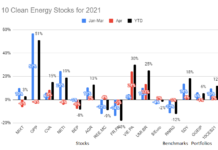Tom Konrad CFA

In my model portfolios of ten clean energy stocks for 2013 andsix alternatives, three companies are currently delaying earnings announcements for various reasons, and at least two of the three will be restating previous results.
Many investors flee the scene at the first whiff of accounting problems: All investors rely on a company’s financial statements (directly or indirectly) to value companies. If there is any doubt as to the accuracy of those statements, they believe it’s better to invest elsewhere.
In contrast, I believe that we never have anything like an accurate picture of what is going on at the companies we own. Uncertainty is always present, how much is just a matter of degree. Even accurate financial statements are the shadows dancing on a cave wall in Plato’s cave. Knowing I’m always operating in a climate of investment uncertainty, I’m willing to consider investing in a company with questionable accounts if the uncertainty seems limited and is more than compensated for by a low stock price.
As always in investing, the question should be, “Do you think reality is better or worse than the what the vast majority of investors assume?” If reality is worse than it appears, you should sell. If it’s better, you should buy or hold. Earnings restatements can be just the tip of an iceberg of accounting troubles, or they be the rough that hides a diamond.
Below, I take a look at what’s going on at Lime Energy (NASD:LIME).
I initially intended to deal with Maxwell Technologies (NASD:MXWL), and Ameresco, Inc. (NYSE:AMRC) in this article as well, but the article kept growing longer. I’ve split it up in order to publish each part as I finish it. Here are the links to the parts about Maxwell and Ameresco.
At the start of the year when I included Lime in my list, its accounting problems were well known and ongoing. They started with the announcement last July that the company would be delaying its second quarterly report, and that annual reports for 2010 and 2011 would have to be restated because of problems with revenue recognition. Most worryingly, the company stated that “non-existent revenue may have been recorded.”
Timing of revenue recognition can be very subjective, and honest accountants can differ about when money flowing in to the company should be booked as sales. However, booking non-existent revenue means that someone was attempting to present a false picture of how much money was actually flowing in. This is not a judgement call, it’s called lying. In that case, the only question is, “Who was lying, and who knew about it?”
As such, Lime’s are the most serious sort of accounting problem. Most investors would sell at any price to avoid a company that had been creating sales out of thin air. The reasons I remained invested in the company were:
Unfortunately, the account
ing problems were much worse (at least in complexity, and possibly in magnitude) than the board initially thought. After repeated delays in filing the corrected statements, Lime announced in December that it was broadening the potential of restatement to include its 2009 financial statements. Also in that announcement, they did not make any claims as to the magnitude of the potential restatements. I take this to imply that the total size of the mis-stated or fictitious revenue may exceed $15 million.
On the encouraging side, the late expansion of the investigation lends credibility to the assumption that top management was not aware of the problems. Also, Lime’s largest shareholder and board chairman continued to put money into the company at prices well above the $0.56 it was trading for at the end of 2013, which is why I included it in my clean energy stock picks this year.
For now, the only information we have are announcements about company’s continued efficiency programs run for its utility customers, and the sale of a non-core business unit. Both of these are encouraging signs, but the only things we know for certain at this point are that the company’s books were a total mess, and Lime can be now bought for a fraction of what (supposedly informed) insiders were willing to pay a year ago.
Conclusion
Had I known Lime’s problems would be this bad last July, I too would have sold immediately. Now, however, I have trouble seeing how the news could get much worse. I believe the many delays have led the vast majority of investors to completely give up on this stock. I consider it a gamble, but one where the odds are on my side.
For now, I’m waiting for the earnings restatements to remove the clouds of uncertainty hanging over Lime.
Disclosure: Long LIME, AMRC
This article was first published on the author’s Forbes.com blog, Green Stocks on March 12th.
DISCLAIMER: Past performance is not a guarantee or a reliable indicator of future results. This article contains the current opinions of the author and such opinions are subject to change without notice. This article has been distributed for informational purposes only. Forecasts, estimates, and certain information contained herein should n
ot be considered as investment advice or a recommendation of any particular security, strategy or investment product. Information contained herein has been obtained from sources believed to be reliable, but not guaranteed.








